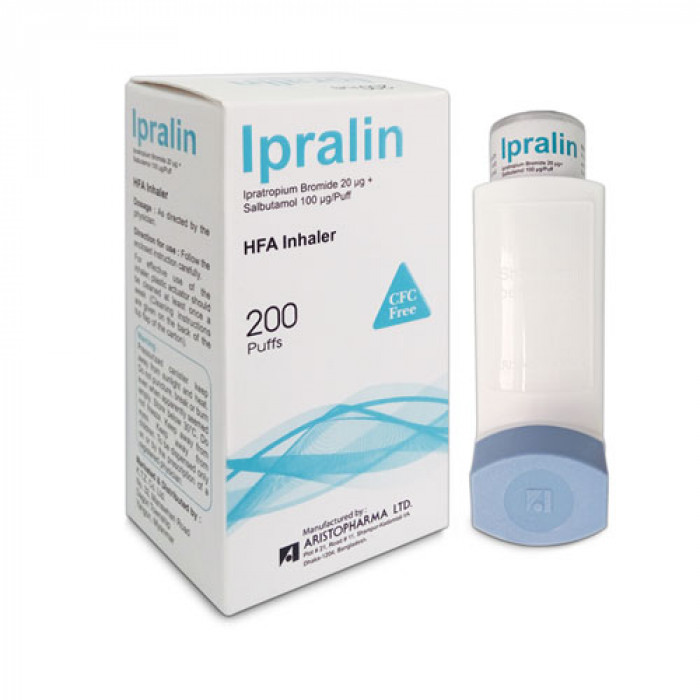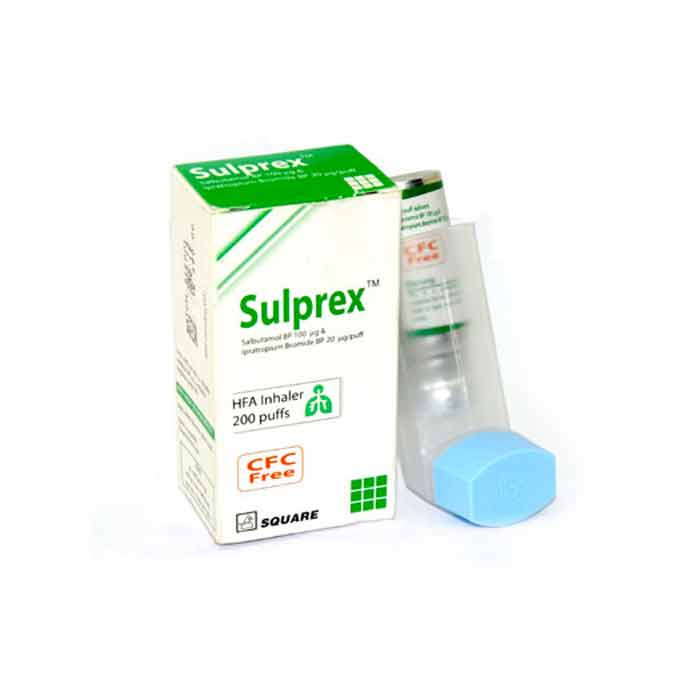

✔ 100% Authentic Product

Ipralin HFA Inhaler
Generic: Ipratropium Bromide 20 mcg + Salbutamol 100 mcg/Metered Inhalation Aerosol Inhalation
Type: Inhalation
Pack Size: 1 Pc
Inhalation Manufacturer/Distributor: Aristopharma Limited Generic Name: Ipratropium Bromide 20 mcg + Salbutamol 100 mcg/Metered Inhalation Aerosol Inhalation

100% Genuine Products, Guaranteed
Safe & Secure Payments, Always
Fast, Secure & Efficient Delivery
Proper Packaging
Cashback offer(Optional):
- 🏷 Coupon CASH55 ✔️ Get ৳55 back - for Ordering ৳500+
- 🏷 Coupon CASH120 ✔️ Get ৳120 back - for Ordering ৳1200+
- 🏷 Coupon CASH200 ✔️ Get ৳200 back - for Ordering ৳2500+
- 🏷 Coupon CASH300 ✔️ Get ৳300 back - for Ordering ৳3500+
- 🏷 Coupon CASH400 ✔️ Get ৳400 back - for Ordering ৳4500+
- 🏷 Coupon CASH500 ✔️ Get ৳500 back - for Ordering ৳5500+
- 🔹 Delivery charge is applicable for Cashback offer
- 🔹 Foreign manufacturer products are not applicable for Cashback offer
Show More
 Cash on Delivery - All over Bangladesh
Cash on Delivery - All over Bangladesh Urgent Delivery - 2 Hours Dhaka City
Urgent Delivery - 2 Hours Dhaka City ফ্রি ডেলিভারি! - ১৪৯৯ টাকা+ অর্ডারে ঢাকা
শহরে ।
ফ্রি ডেলিভারি! - ১৪৯৯ টাকা+ অর্ডারে ঢাকা
শহরে । ফ্রি ডেলিভারি! - ২৯৯৯ টাকা+ অর্ডারে ঢাকার
বাহিরে ।
ফ্রি ডেলিভারি! - ২৯৯৯ টাকা+ অর্ডারে ঢাকার
বাহিরে ।
✅ Description:
Indications
Ipralin HFA Inhaler is indicated for use in patients with chronic obstructive pulmonary disease (COPD) on a regular aerosol bronchodilator who continue to have evidence of bronchospasm and who require a second bronchodilator.
Pharmacology
Salbutamol (as Sulphate) and Ipratropium Bromide are combined in this inhalation aerosol. It's a hydrofluoroalkane (HFA)-based inhaler that's good for the environment. Because it does not use chlorofluorocarbons (CFCs), which are one of the primary causes of ozone layer depletion.
Ipratropium Bromide is an anticholinergic bronchodilator and Salbutamol is a short-acting beta2-adrenergic bronchodilator. Ipratropium Bromide reduces the increase in intracellular concentration of cyclic guanosine monophosphate induced by acetylcholine contact with the muscarinic receptor on bronchial smooth muscle when administered in combination. By lowering bronchospasm through two independent mechanisms, anticholinergic (parasympatholytic) and sympathomimetic, this inhalation aerosol is intended to maximize the therapy response in patients with chronic obstructive pulmonary disease (COPD). Simultaneous administration of an anticholinergic (Ipratropium Bromide) and a beta 2-sympathomimetic (Salbutamol) is intended to assist the patient by creating a stronger bronchodilatory effect than when each medicine is used at its recommended dosage alone.
Dosage and Administration
Adult dose (Including the elderly): 2 puffs of Salpium 4 times a day (Patients may take additional puffs as required but a total number of puffs should not exceed 12 in 24 hours). Or as directed by the physician.
Using an Inhaler seems simple, but most patients do not know how to use it in the right way. If the Inhaler is used in the wrong way, less medicine can reach the lungs. Correct and regular use of the Inhaler will prevent or lessen the severity of asthma attacks.
Following simple steps can help to use Inhaler effectively (According to "National Asthma Guidelines for Medical Practitioners" published by Asthma Association):
Take off the cap.
Shake the inhaler (at least six times) vigorously before each use.
If the inhaler is new or if it has not been used for a week or more, shake it well and release one puff into the air to make sure that it works.
Breathe out as full as comfortably possible & hold the inhaler upright.
Place the actuator into mouth between the teeth and close lips around the mouthpiece.
While breathing deeply and slowly through the mouth, press down firmly add fully on the canister to release medicine.
Remove the inhaler from mouth. Continue holding breath for at least for 10 seconds or as long as it is comfortable.
If doctor has prescribed more than one inhalation per treatment, wait 1 minute between puffs (inhalations). Shake the inhaler well and repeat steps 4 to 7.
After use, replace the cap on the mouthpiece. After each treatment, rinse mouth with water.
Check your technique in front of a mirror from time to time, if you see a white mist during the inhalation, you may not have closed your lips properly around mouthpiece, or you may not be breathing in as you press the can. This indicates failure of technique. If this happens, repeat the procedure from step 4 carefully.
Instructions for Cleaning Inhaler: Clean your Inhaler at least once a week. Remove canister and rinse the plastic actuator and cap in warm water but do not put the metal canister into water. Dry the actuator and cap thoroughly and gently replace the metal canister into the actuator with a twisting motion. Put the cap on the mouthpiece.
Interaction
This inhalation aerosol has been used in conjunction with other medicines for COPD treatment, such as sympathomimetic bronchodilators, methylxanthines, and steroids. There have been no formal drug interaction studies with this inhalation aerosol and these or other drugs routinely used to treat COPD. Ipratropium Bromide should be used with caution when combined with other anticholinergic and sympathomimetic drugs, as this may raise the risk of cardiovascular complications. In patients on non-potassium sparing diuretics, monoamine oxidase inhibitors, or tricyclic antidepressants, beta-2-agonist-containing medicines, such as this inhalation aerosol, should be used with extreme caution.
Contraindications
Ipralin HFA Inhaler is contraindicated in patients with a history of hypersensitivity to soya lecithin or related food products such as soybean and peanut. Ipralin HFA Inhaler is also contraindicated in patients hypersensitive to any component of the drug product or to atropine or its derivatives.
Side effects
Headache, pain, influenza, bronchitis, dyspnea, coughing, respiratory disorders, pneumonia, upper respiratory tract infection, pharyngitis, sinusitis, rhinitis have been reported. Additional adverse reactions reported include edema, fatigue, hypertension, dizziness, nervousness, paresthesia, tremor, dysphonia, insomnia, diarrhea, dry mouth, dyspepsia, vomiting, arrhythmia, palpitation, tachycardia, arthralgia, angina, increased sputum, taste perversion, and urinary tract infection/dysuria.
Pregnancy & Lactation
Use in pregnancy:
Pregnancy Category C. There are no adequate and well-controlled studies of ipratropium bromide and salbutamol sulfate inhaler, ipratropium bromide or salbutamol sulfate, in pregnant women. Ipralin HFA Inhaler should be used during pregnancy only if the potential benefit justifies the potential risk to the fetus.
Use in lactation:
It is not known whether the components of Ipralin HFA Inhaler are excreted in human milk. Ipralin HFA Inhaler should not be used by breastfeeding mothers, unless the expected benefit is thought to outweigh the risks.
Use in children:
Safety and effectiveness in the pediatric population have not been established.
Precautions & Warnings
Ipratropium bromide containing inhaler should be used with caution in patients with narrow-angle glaucoma, prostatic hyperplasia or bladder-neck obstruction.
Salbutamol sulphate containing inhaler should be used with caution in patients with convulsive disorders, hyperthyroidism, or diabetes mellitus and in patients who are unusually responsive to sympathomimetic amines.
Beta-adrenergic agents may also produce significant hypokalemia in some patients (possibly through intracellular shunting) which has the potential to produce adverse cardiovascular effects. The decrease in serum potassium is usually transient, not requiring supplementation. Combination of Ipratropium and Salbutamol Inhaler has not been studied in patients with hepatic or renal insufficiency. It should be used with caution in those patient populations.
Therapeutic Class
Combined bronchodilators
Storage Conditions
Even if the pressurized canister appears to be empty, do not puncture, damage, or incinerate it. Avoid storing in direct sunlight or in a hot environment. Store in a cool, dry location. Keep your distance from youngsters. Keep your distance from the eyes.
Disclaimer:
ePharma sole intention is to ensure that its consumers get proper
information as musch as possible. Although we do not guarantee the
accuracy and the completeness of the information that provided and
here information is for informational purposes only.
The information contained herein should NOT be used as a substitute
for the advice of a qualified physician. This may not cover
everything about particular health conditions,
lab tests, medicines, all possible side effects, drug interactions,
warnings, alerts, etc. Please consult your healthcare professional
and discuss all your queries related to any disease or medicine. We
intend to support, not replace, the doctor-patient relationship.





